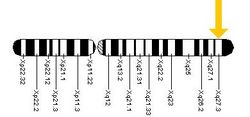Instability of repetitive sequences
Dynamic mutations
Mutation is defined as a suden, undirected and permanent change in genetic material. However, this characteristic is not met by the type of mutations that we call dynamic mutations. Dynamic mutations are associated with the expansion of an unstable element (mostly a repeated trinucleotide) that is amplified with a gene, either in a coding region (exon) or in a non-coding part, i.e. in a promoter or in an intron. The standart alleles of these genes are polymorphic, i.e. they have a variable, mostly small number of repetitions of a certain triplet. This repeat can be increased during the transmission of the gene from generation to generation to such an extent that it results in a change in gene expression or function of the gene produuct, which is associated with clinical impairment. Amplification (multiplication) is caused by an error during replication, when the repetition of trinucleotides causes inaccuracy in the pairing and the formation of a protrusion of the daughter DNA chain and repeated replication of the segment.
Diseases associated with multiplication of trinucleotide repeats
Syndromes associated with this type of mutation show deviations from the expected mode of transmission, deviations such as anticipation (Sherman's paradox), which means a worsening of sympoms from generation to generation, or a shortening of the onset of the disease in subsequent generations, as well as the dependence of the severity of the disease on parental origin (transmission) mutation. The dependence of trinucleotide expansion on the sex of the transmitting parent has been described in fragile X syndrome and in myotonic dystrophy, when a large increase in amplification occurs during maternal transmission - in fragile X it leads to a change of premutation in a full mutation (associated with disability in sons), in myotonic dystrophy to severe congenital forms of the disease. In Huntington's disease, amplification of the element during paternal transmission leads to an earlier onset of the disease.
Other specifics of these diseases are the homogeneity of mutations (the vast majority of mutations are of the amplification type, classic mutations occur only exceptionally in these diseases), somatic variability in the number of trinucleotide repeats in different tissues, no new mutations are known, i.e. the emergence of a full mutation (a large number of repeats) is always gradual - these are familiar diseases, the severity of the disease depends on the number of repetitions.
The most well-known diseases associated with dynamic mutation include the fragile X mutation (Martin-Bell syndrome), Huntington's chorea, myotonic dystrophy and Friedreich's ataxia.
There are two groups of dynamic mutations:
- A mutation with amplification in the non-coding - untranslated region of the geene (promoter, intron) leads to a change in gene expression, such as in fragile X syndrome (amplified CGG triplet in the 5' untranslated region of the gene FMR1 = Fragile X Mental Retardation 1), in myotonic dystrophy (amplified triplet CTG in the 3' untranslated region of the gene for the protein kinase DMPK) and in Friedreich's ataxia (amplified triplet AAG in the intron of the gene for the mitochondrial protein frataxin)
- Amplification in an exon (usually a CAG triplet) does not affect gene transcription, but the resulting protein is abnormal (containing a polyglutamine tract). This is known in Huntington's disease (huntingtin protein) and in some other progressive neurodegenerative diseases (so-called polyglutamine disorders).
Fragile X Syndrome
Fragile X syndrome (FXS) is a X-linked genetic disorder, which is connected with the mutation of FMR 1 gene. Patients, who suffer from FXS have intellectual and also physical disability, which influence their life seriously. Because of the connection to X-chromosomes, it is clear, that especially male are affected more often and their symptoms are worse. The premutation of FMR 1 gene leads to FXTAS (Fragile X-associated Tremor/Ataxia Syndrome).
Etiology and Pathogenesis
The disorder is connected with changes of FMR 1 gene, especially with the amount of CGG triplets:
- Healthy people – under 50 repeats
- Premutation (FXTAS) – from 50 to 200 repeats
- Full mutation (FXS) – over 200 repeats
In people, who have more than 200 CGG repeats on their X-chormosome, we can find a specific methylation, which turns off the gene. The result is a lack of fragile X protein (FMRP).
Symptoms
- Mental retardation – learning disabilities, intellectual skills
- Typical facial features – long face with big ears and sensitive skin
- Macroorchidism – after puberty
- Behavioral disorders – aggression, autism
Diagnosis
Althought the early diagnosis is necesarry if we want to eliminate serious disabilities, there are just few sings, which can help us to make a right diagnostic conclusion. In babies with FXS we can find larger head circumferences. Facial features and macroorchidism become more prominent during adolescence, when it is usually little bit late to influence mental disorders.
Much more important seems to be the area of molecular diagnostics and also family history can help us very much. Children with FXS have usually some relative (grandparents or parents), who suffer from FXTAS. FXTAS is a premutation syndrome, which can be inherited to the next generation. When premutation start to expand CGG triplets (over 200 repeats), carriers then develop fragile X syndrome. We have to search for FXS in the families where FXTAS have appeared.
Therapy
Nowadays, there is no specific treatment of FXS, althought we know a lot about the etiology. There are many researches, which maybe in future can lead to the discovery of some molecular based treatment.
In the meantime we can only minimize the symptoms. The early intervention is necesarry because of brain damage prevention. Individualized school plan can help children to improve their intellectual skills. The team of psychologists and special teachers can cooperate with a small patient´s parents. Speech and occupational therapy is also required. Our medication options are poor, but we should combinate them with the other types of therapy. We use antidepressants, anxiolytics, psychostimulants.
Links
Related articles
References
- THOMPSON, James Scott – THOMPSON, Margaret Wilson – NUSSBAUM, Robert L. Klinická genetika: Thompson & Thompson. 6. edition. Triton, 2004. 426 pp. ISBN 80-7254-475-6.
- NUSSBAUM, R. – MCINNES, R. R. – WILLARD, H. F. Thompson & Thompson: Genetics in Medicine. 7. edition. Saunders, 2007. 600 pp. ISBN 1416030808.



